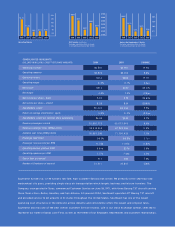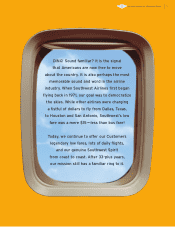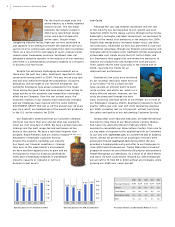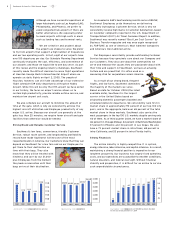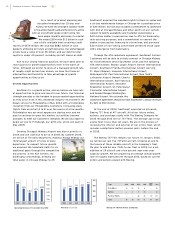Southwest Airlines 2004 Annual Report Download - page 5
Download and view the complete annual report
Please find page 5 of the 2004 Southwest Airlines annual report below. You can navigate through the pages in the report by either clicking on the pages listed below, or by using the keyword search tool below to find specific information within the annual report.
4Southwest Airlines Co. 2004 Annual Report
For the fourth straight year, the
airline industry, as a whole, reported
massive losses. The two major
problems the industry faced in
2004 were record-high energy
prices and a glut of domestic
airline seats. Despite these
staggering industry losses, high-cost carriers continued to
add capacity in an attempt to thwart the growth of low-cost
carriers (LCCs), selling seats well below their costs to produce
them. As a result of this oversupply of seats, revenue yields
remain under tremendous pressure. Southwest does not
anticipate a complete recovery in the industry’s or our revenues
until there is a rationalization of industry capacity or a recovery
in business full-fare travel.
Despite the extremely challenging environment we’ve
faced over the past four years, Southwest reported its 32nd
consecutive annual profit in 2004. This was not an easy task
and was only achieved through the preparation, discipline,
dedication, and foresight of our resilient Employees. Our
wonderful Employees have always prepared for the tough
times during the good times and have always been willing to
adapt quickly to the economic and competitive challenges
affecting our Company. Over the last several years, the
economic realities in our industry have drastically changed,
and our Employees have reacted with the same fighting
SOUTHWEST SPIRIT that got us off the ground over 33 years
ago. As a result, we remained one of the lowest cost producers
in the U.S. airline industry for 2004.
Our Employees understand that our Customers demand
low fares now more than ever and did what was needed to
lower our cost structure in 2004. We have a proven business
strategy and the most respected and well-known airline
brand in the country. We have a top-rated frequent flyer
program, Rapid Rewards, and are widely recognized for our
Employees’ remarkable Customer Service.
Despite the economic hardships our industry
has faced, our financial condition is stronger
than ever. In this weak industry environment,
we have excellent opportunities to grow and are
well-poised to return to historical profitability
levels once a meaningful reduction in unprofitable
industry capacity or rebound in full-fare
business travel occurs.
Low Costs
Although the cost gap between Southwest and the rest
of the industry has narrowed due to LCC growth and cost
reduction efforts by the legacy carriers through restructuring,
bankruptcy, furloughs, and labor concessions, we continued to
be one of the lowest cost producers in the industry for 2004.
Despite high energy prices, increased airport costs, and labor
rate pressures, Southwest Airlines has protected its low-cost
competitive advantage through our People’s perseverance and
strenuous efforts to reduce costs. Southwest Airlines experienced
unfavorable cost trends during the first half of 2004, and
our Employees took aggressive and innovative measures to
improve our productivity and mitigate the cost pressures.
Their superb efforts were successful in the second half of
2004, reversing the trends for an
improved cost performance.
Southwest’s low costs were instituted
by our strategic decisions made early on
in our history——to fly a single aircraft
type; operate an efficient point-to-point
route system; and utilize our assets in a
highly efficient manner. However, our low
costs are preserved through the hard
work, creativity, and high spirits of our People. As a result of
our Employees’ amazing efforts, Southwest reduced its fourth
quarter 2004 year over year unit costs (operating expenses
per ASM), excluding fuel, by 4.5 percent, without sacrificing
the safety and quality of our outstanding Customer Service.
Among other cost reduction measures, we made the difficult
decision to close three of our Reservations Centers (Dallas,
Salt Lake City, and Little Rock) in February 2004. The
decision to consolidate our Reservations Centers from nine to
six was made in response to the established shift by Customers
to our web site, southwest.com, as a preferred way of booking
travel. Almost 60 percent of our passenger revenues were
generated through southwest.com during 2004. We also
provided a Companywide early-out offer to our Employees in
June 2004 and introduced our “Going Where We’re Growing”
program to ensure we are efficiently utilizing our extraordinary
People throughout our operations. As a result of all these efforts
and more, we have successfully reduced our 2004 headcount
per aircraft to 74 from 85 in 2003 without any furloughs, while
growing our ASMs over seven percent.
2000 2001 2002 2003
Operating Expenses Per Available Seat Mile
7.73¢
7.54¢
7.41¢
2004
7.60¢
7.77¢
7.8¢
7.6¢
7.4¢
7.2¢
7.0¢
2000 2001 2002 2003
Operating Expenses Per ASM, Excluding Fuel
6.38¢ 6.36¢
6.30¢
2004
6.44¢ 6.47¢
6.5¢
6.4¢
6.3¢
6.2¢
6.1¢
Passenger Revenues and Distribution Method
(in millions)
$5,468 $5,379
24%
$5,341 $5,741
31%
25%28% 20%
59%
$6,280
39% 49% 54%
16% 13%
18%28% 20% 19%
Internet
Passenger Revenues
Travel Agency
Reservations Center
12%10%13% 11%11%
Other
2000 2001 2002 2003 2004

